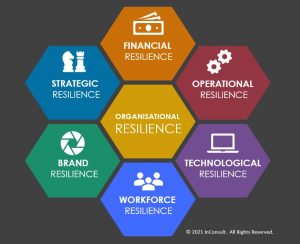Achieving resilience has never been more important for the board. The current business environment is characterised by high inflation, low GDP, high interest rates, less access to capital, supply chain disruptions, increases in both the frequency and complexity of cyber attacks and geopolitical instability. Many boards believe that their companies are generally better prepared to deal with these events, but feel more exposed to larger-scale forces, major crises, black swans, macroeconomic shocks and climate change transition risks.
Add to this, the likelihood that severe shocks and catastrophic events will become more common, less predictable and unfold quickly through social media. The sources of risk will be wider and consequences more complex.
In this context, building, or in some cases strengthening resilience has become a top priority for companies striving for long-term success.
Shocks are real, not theoretical. Organisations must be prepared. The board of directors play a crucial role in steering the organisation through turbulent waters and ensuring the organisation’s ability to adapt, recover, and thrive.
In this article, we explore 10 essential strategies that boards can employ to build corporate resilience within their company.
What is resilience?
ISO 22316:2017 Organisational resilience — Principles and attributes, defines organisational resilience as “the ability of an organisation to absorb and adapt in a changing environment to enable it to deliver its objectives and to survive and prosper.”
Resilience in the corporate context refers to an organisation’s capacity to withstand and recover from adverse situations, adapt to change, and continue its operations effectively. It goes beyond risk management by encompassing a proactive and holistic approach to prepare for unforeseen events.
Resilience means both protecting against the downside of potential shocks and preparing to capture the upside.
Business resilience is crucial to achieve because it enhances the company’s capacity to protect its reputation, retain stakeholder trust, and capitalise on opportunities, ultimately contributing to sustained growth and success.
1. Strategic Vision and Adaptive Leadership
At the core of building resilience is a strategic vision that anticipates and embraces change. Boards should work closely with the executive team to develop and communicate a clear, flexible, and forward-looking strategy. Adaptive leadership, characterised by the ability to respond effectively to new challenges, is essential. Boards should foster a culture that values innovation and encourages executives to experiment with new ideas and approaches.
2. Skilled, Diverse and Inclusive Board
Collectively, the board must have a broad range of skills and experience. The diverse expertise and knowledge within the board contribute to informed decision-making, strategic planning, and the ability to navigate the complexities of the business environment.
Diversity and inclusivity are not only ethical imperatives but also critical components of a resilient board. A diverse range of perspectives, experiences, and skills can enhance decision-making processes, enabling the board to consider a broader spectrum of risks and opportunities. An inclusive culture fosters open communication and creativity, which are essential elements in navigating uncertain times.
3. Effective Risk Management
While risk management is a fundamental element of corporate governance, resilient boards go beyond mere compliance. They actively anticipate, identify and assess risks, considering both internal and external factors. Boards must establish a robust risk management framework that includes regular risk assessments, scenario planning, and stress testing.
The risk register should go beyond identifying risks and controls and include response strategies in the event the risk eventuate. This enables the organisation to anticipate potential challenges and formulate effective response strategies.
4. Financial Resilience and Flexibility
A resilient company maintains a strong financial foundation and embraces financial prudence. Boards should work closely with the Chief Financial Officer and financial team to ensure sound fiscal policies, healthy cash reserves, and flexible financial structures.
Having sufficient capital and the flexibility to adapt financial strategies in response to changing market conditions allows the company to weather economic downturns and capitalise on emerging opportunities.
5. Stakeholder Engagement and Communication
Effective communication is pivotal in times of uncertainty. Resilient boards prioritise stakeholder engagement and transparent communication. This includes regular and clear communication with shareholders, employees, customers, and other relevant stakeholders. By keeping stakeholders informed and engaged, the board fosters trust and confidence in the company’s ability to navigate challenges.
6. Talent Management and Employee Well-being
A resilient company places a premium on its human capital. Boards should collaborate with the executive team to implement robust talent management strategies, including training and development programs, succession planning, and employee well-being initiatives. A satisfied and motivated workforce is more likely to weather challenges and contribute to the organisation’s resilience.
7. Technology and Digital Resilience
In an era of rapid technological advancement, resilient boards embrace digital transformation as a strategic imperative. This involves leveraging technology to enhance operational efficiency, improve customer experiences, and stay ahead of industry disruptions. Boards should work closely with technology leaders to invest in digital infrastructure, cybersecurity measures, and innovation initiatives that position the company for long-term success.
8. Supply Chain Resilience
Globalisation has interconnected supply chains, making them susceptible to disruptions. Resilient boards assess and enhance the resilience of their supply chains by diversifying sources, building strategic partnerships, and implementing robust contingency plans. Understanding and mitigating vulnerabilities in the supply chain contribute to the overall resilience of the organisation.
9. Adaptation to Regulatory Changes
The regulatory landscape is constantly evolving, and compliance is a critical aspect of corporate resilience. Boards must stay informed about changes in regulations relevant to their industry and geography. Proactive engagement with regulatory bodies and legal counsel helps ensure that the company is well-prepared to adapt to new requirements and navigate potential compliance challenges.
10. Continuous Learning and Evaluation
Building resilience is an ongoing process that requires continuous learning and evaluation.
Resilient boards establish mechanisms for regular evaluations, learning from both successes and setbacks. This may involve post-event reviews, benchmarking against industry best practices, and adapting strategies based on lessons learned.
The 6 Pillars of Resilience
In our view, an organisation needs to strengthen these 6 pillars of resilience.
- Strategic Resilience – the ability to anticipate, adapt, and respond to changes in the business environment while maintaining a clear and forward-looking strategic vision.
- Financial Resilience – the capacity of a company to endure and recover from financial challenges or economic downturns.
- Operational Resilience – the ability to sustain its essential functions and adapt its operations in the face of disruptions.
- Technological Resilience – the ability of a company to withstand and recover from disruptions related to its technological infrastructure and systems.
- Workforce Resilience – the strength and adaptability of an organisation’s human capital in response to challenges such as changes in the labor market, organisational restructuring, or unexpected events like pandemics.
- Brand Resilience – the ability to maintain a positive brand image and reputation, especially in the face of adverse events or crises.

Read our full article Seeking Resilience: How to Become a More Resilient Organisation to find out more about the 6 pillars.
How we can help you be more resilient
We are here to help strengthen organisational resilience. Our resilience capabilities include designing and developing a wide range of response plans to enhance your resilience posture and capabilities. These response plans include:
- Business continuity plan
- Contingency plan
- Pandemic plan
- Succession plan
- Crisis management plan
- Financial recovery plan
- IT-Disaster recovery plan
- Data breach incident response plan
- Emergency management plan
Be more resilient to a wide range of shocks and contact us to discuss any gaps in your resilience framework.
